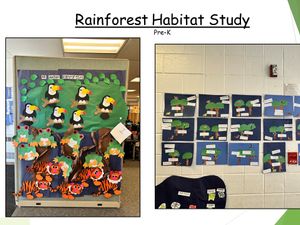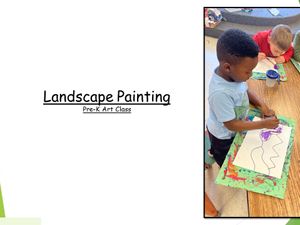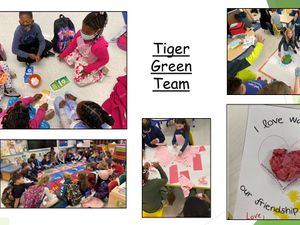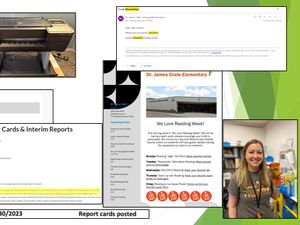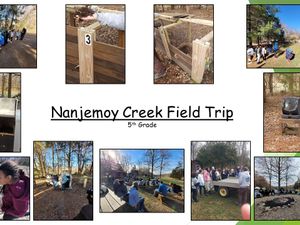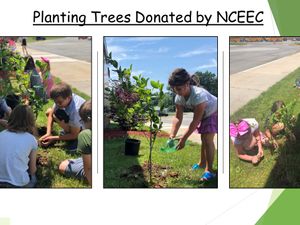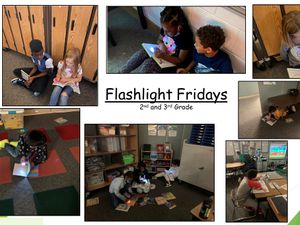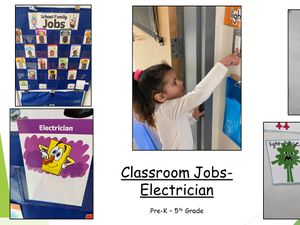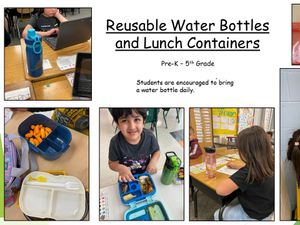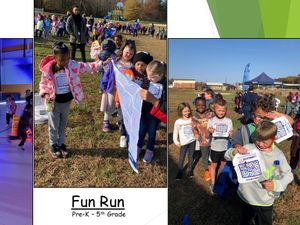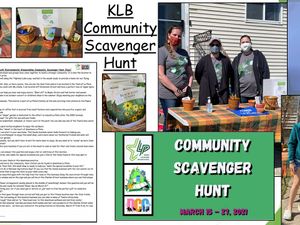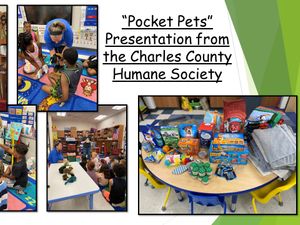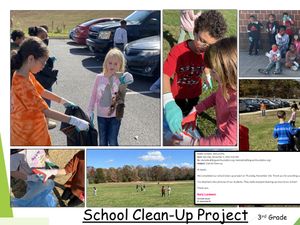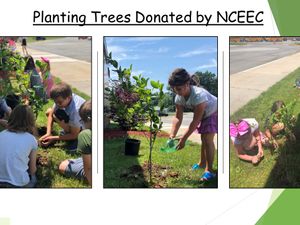Systemic Sustainability
Environmental Curriculum and Instruction
1.1 Curriculum and Instruction
Elementary & middle schools must provide one example of outdoor/environmental instruction per grade level.
High schools must provide one example of outdoor/environmental instruction in four subjects (which may include multiple different differents sciences).
Students read the story, We're Going on a Leaf Hunt by: Steve Metzger. After reading the story, students went on their own leaf hunt. They used what they found outside to have a scavenger hunt and match items. They also used what they found and made a sensory bin. They explored the different color leaves and made their own leaf with tissue paper.
Students completed a unit on habitats. The Pre-K class learned about the different layers of the Rain Forest. They read Fiction as well as Non-Fiction books to identify the information that was true about the Rain Forest. Students then created a display to show what they learned about the Rain Forest. Students compared the Rain Forest habitat to other habitats in their natural environment.
Students participated in lessons about what it means to recycle and reuse items in their environment to make something new. After completing their Unit: Our Environment, and reading books about recycling and how they can help the earth, students demonstrated their knowledge about reusing items and they made their own game or toy out of recycled items at home.
Students participated in the lesson Pumpkin Jack. This lesson introduced students to growing a pumpkin from the seeds in a pumpkin plant. Students listened to the book Pumpkin Jack by: Will Hubbell. They made predictions about what would happen to Pumpkin Jack overtime. Following the day of the lesson, students were able to make and record observations and what they noticed about their pumpkin in the jar. Students learned about the process of plant to seed. Students were able to visit the pumpkin every day to observe how the pumpkin decomposes and is transformed into several new plants. Before reading the story, students also learned about the life cycle of a pumpkin and were able to describe pumpkins.
During April 2022, students participated in "Rain Clouds" as their monthly science fun. This fun science lesson helped students understand rain because as we all know, "April showers bring May flowers." Students learned how clouds form by retaining water and how water builds up in a cloud before raining. Students were also introduced to each season and compared the different types of weather that occur each season.
Students were introduced to the meaning of the word "protecting." Students discussed what effects the earth and what they can do to protect the earth. Students also discussed deforestations and what would happen if too many resources were used, such as food, water and resources to make a shelter. As an assessment students completed an online form instead of the traditional pencil paper to represent protecting our earth from pollution.
Students went on a scavenger hunt to find different plants, bugs, and greenery outside. Students were learning about different types of physical resources that are in the environment. They were able to use their finders to look through at the smaller animals and get close to the flowers. Students used "finders" that were made from old dry-erase paddle boards. The "finders" were created using repurposed dry-erase boards.
3rd grade students participated in a field trip to Hard Bargain Farm. On their trip, they learned about red wriggler worms. They took their new knowledge about red wriggler worms and applied it to their Farmer Will Allen lesson. They read Farmer Will Allen and the Growing Table and used their knowledge of red wiggler worms to talk about compost and how those worms can help with compost. The story introduced students to soil.
Students read Farmer Will Allen and the Growing Table. They discussed point of view and made connections to the story from what they learned on their field trip to Hard Bargain Farm.
Students went on a field trip to Hard Bargain Farm. During their trip, they learned about Red Wriggler Worms. They used what they learned about these worms to make connections to the story they read in class.
Students had the opportunity to participate in a field trip to St. Mary's City to go along with their study of the colonization of Maryland. Part of the requirements of the trip was to bring a waste free lunch. The 4th grade students completed a lesson on what a waste free lunch is and why it is important. They watched a video and had a discussion on the importance of being waste free to help our environment. Students watched a video that introduces the topic of waste-free lunch. A variety of containers are shown (chip bags, food storage containers, juice boxes and reusable drink cups, paper, plastic, and reusable bags.) Students first sorted waste-free and waste items. Then, students shared changes they could make to their lunch to make it waste-free. Culminating in a field trip for which students had to pack a waste-free lunch.
Students previewed a Waste-Free Lunch video and had a discussion about why it is important to have waste-free lunches. They learned how to have a waste-free lunch.
Approved St. Marys Letter home 22 (158.98 KB)
This is a copy of the permission slip encouraging a waste-free lunch.
Students in the 5th grade classes learned how to be Watershed Stewards of our Schoolyard. They completed a Schoolyard Scorecard to see the condition and biodiversity of our schoolyard. They used a Google map to answer some of their questions. They completed this lesson using some of the information they learned on their field trip to Nanjemoy Creek.
Students worked together to explore attributes of pumpkins. They used their five senses to observe and describe pumpkins. They measured pumpkins and compared them by size and then experimented and investigated to determine if pumpkins will sink or float.
Throughout the 2020-2021 school year, students engaged in Cosmic Kids Yoga sessions during PE class. These were done in the virtual and hybrid format over Zoom meetings. These yoga sessions helped students practice mindfulness and also encouraged movement and breathing techniques. Many of the yoga lessons used presented topics related to the environment such as underwater, bugs, Earth Day and more!
Students in the Pre-K class studied landscapes and the shapes, lines and forms found in landscapes. They identified earth features found in landscapes. Students used what they learned in Art class and the examples they were shown to draw their own landscapes.
First grade students observed the butterfly life cycle. Each class received caterpillars and observed the cycle to butterfly. Students not only observed daily, but they also recorded their observations in a journal.
Students in the first grade classes participated in reading a poem about Arbor Day. After reading the poem, students had a discussion about what Arbor Day is and how it is celebrating. Students came up with ways that planting trees helps the environment.
Students in the Tiger Green team met monthly to learn various green lessons and tips. During the 2020-2021 school year we met virtually and in 2021 we brought back in-person meetings. During our meetings, members learn many Environemtal topics and complete lots of hands-on activities.
1.2 Green School Awareness
1.2.1 School Wide Awareness - Staff
Demonstrate that all school personnel are aware of your school's Green School status and application process.
Throughout the last 4 years, staff at Dr. James Craik have actively planned and implemented environmental and green school lessons. During a staff meeting, staff were made aware of the recertification process and asked to continue to document and compile activities and artifacts from these lessons. Staff were also asked to maintain and document any environmental professional developments they actively participated in. During a staff meeting we educated the staff on our Green School initiatives. We discussed ways that each staff member could take part in creating a sustainable school environment.
During a staff meeting, staff were made aware of the recertification process and asked to continue to document and compile activities and artifacts from these lessons. Staff were also asked to maintain and document any environmental professional developments they actively participated in. During a staff meeting we educated the staff on our Green School initiatives. We discussed ways that each staff member could take part in creating a sustainable school environment.
1.2.2 School-Wide Celebration
Demonstrate how your school celebrates beig a Green School by hosting a school-wide environmentally-focused event open to all students.
On March 3, 2023, our school celebrated Being Green and shared reasons why they are lucky to have our earth. Each grade level read an environmental book and had discussions or completed fun activities about environmental topics.
On March 3, 2023, our school celebrated Being Green and shared reasons why they are lucky to have our earth. Each grade level read an environmental book and had discussions or completed fun activities about environmental topics.
Pre-K read "10 Things I Can Do to Help My World" and shared ways that they can take care of the earth.
Kindergarten Read "The Lorax" and discussed why trees are so important and how we can keep our earth safe and clean. We then followed up with creating a Lorax craft!
1st Grade read "What if Everybody Did That?" and made posters about taking care of the earth, have a litter pick-up and talked about what would happen if everyone littered.
2nd Grade read "Turtles in my Sandbox" and made a fun turtle craft.
3rd Grade read "Our Great Big Backyard" and illustrated what we could find in our own backyards.
4th Grade read "Eco-Friendly Foods"
5th Grade read "The Adventures of a Plastic Bottle"
Pre-K read "10 Things I Can Do to Help My World" and shared ways that they can take care of the earth.
Kindergarten Read "The Lorax" and discussed why trees are so important and how we can keep our earth safe and clean. We then followed up with creating a Lorax craft!
1st Grade read "What if Everybody Did That?" and made posters about taking care of the earth, have a litter pick-up and talked about what would happen if everyone littered.
2nd Grade read "Turtles in my Sandbox" and made a fun turtle craft.
3rd Grade read "Our Great Big Backyard" and illustrated what we could find in our own backyards.
4th Grade read "Eco-Friendly Foods"
5th Grade read "The Adventures of a Plastic Bottle"
green celebration flyer (44.51 KB)
Green Celebration Flyer
Environmental Professional Development for Teachers
1.3.1 Environmental Professional Development for Teachers
Demonstrate that 10% of staff have completed an environmental PD. Instructional staff is defined as any staff that manages a gradebook.
- New Schools must have all PD completed within the past 2 academic years.
- Renewing schools must have all PD completed within the past 4 academic years.
A teacher who has participated in multiple workshops may only be counted once..
Staff at our school had the opportunity to complete optional professional development, that included environmental focused training. They had the option to participate in 1-3 courses, listed below.
One course was Indoor Air Quality Awareness. This course provides staff with an understanding of the issues surrounding indoor air quality, including the adverse effects of poor IAQ, and some helpful practices for improving the indoor air quality in your facility. The course will review the impact of poor air quality, common indoor air pollutants, and essential good practices.
One course was Energy Conservation. The Goal of this course was to familiarize all staff members with information about energy consumption and costs, along with ways to make energy use less expensive. This course will cover the differences between energy use in your home and at work, the basics of heating and cooling rooms, and smart energy-saving strategies for all staff.
One course was Stormwater Management. This course gives employees an overview of storm water management issues, including storm water pollution, storm water management solutions, as well as the best management practices and more. It will review sources of storm water pollution and their effects on the environment, typical storm water management solutions, the best practices when seeking a "greener" or more natural solution to storm water issues, and policies and regulations surrounding the management of storm water.
One of our staff members completed the
One course was Indoor Air Quality Awareness. This course provides staff with an understanding of the issues surrounding indoor air quality, including the adverse effects of poor IAQ, and some helpful practices for improving the indoor air quality in your facility. The course will review the impact of poor air quality, common indoor air pollutants, and essential good practices.
One course was Energy Conservation. The Goal of this course was to familiarize all staff members with information about energy consumption and costs, along with ways to make energy use less expensive. This course will cover the differences between energy use in your home and at work, the basics of heating and cooling rooms, and smart energy-saving strategies for all staff.
One course was Stormwater Management. This course gives employees an overview of storm water management issues, including storm water pollution, storm water management solutions, as well as the best management practices and more. It will review sources of storm water pollution and their effects on the environment, typical storm water management solutions, the best practices when seeking a "greener" or more natural solution to storm water issues, and policies and regulations surrounding the management of storm water.
Shannon Durst participated in the MAEOE Summer Institute from June 21-23, 2022 and the MWEE 101 Online course.
Shannon Durst participated in the National Ag in the Classroom Virtual Summer Conference.
1.4 Achieving Sustainable Schools
1.4.1 School-Wide Staff Sustainability
Demonstrate the sustainability practices your teachers, staff, and other personnel have implemented school-wide to make your school green. Any actions involving students belong under Objective 2.
-
Our school has moved from paper to digital school newsletters. 100% of families within our school now receive digital school newsletters rather than printed school newsletters. This practice has helped save paper. Our school also uses Facebook and Twitter more frequently to share updates, flyers and fun happenings at our school.
-
Our school has moved from paper to digital report cards. All students now receive their report cards digitally which has helped save paper.
-
Teleworking- During the 2020-2021 school year, many staff took advantage of teleworking from home rather than working in the school building. During the 2022-2023 school year, staff members are taking advantage of teleworking on non-student days. Teleworking has helped save electricity within the school building because the less staff members there are, the less electricity there is being used. Teleworking also means that staff members are not driving on the roads, meaning there are less carbon emissions being released into the air.
-
Microsoft TEAMS/Sharepoint are now being used to share resources amongst staff members rather than printing copies for each individual teacher.
-
When an individual joins our school staff, they are given a welcome gift of a reusable water bottle and introduced to the "green" initiatives we practice at our school. The reusable water bottle allows staff to model using one to hopefully encourage students to do that same.
-
This year our school purchased a poster maker with the goal to cut down using Post-It paper charts and to be able to make posters that can be used throughout the years.
1.4.2 Systemic Partnership
Demonstrate one partnership with a central office or board within the school system that supports part of the Maryland Green Schools Program. Any partnerships outside of your school system belong under Objective 3.
Organization/Company Title: Nanjemoy Creek Enviromental Center
Date: 2019 to Present
Brief Description of Partnership: Nanjemoy Creek Environmental Center continues to support our green initiatives at Dr. James Craik. Educators from the center have visited Craik to teach lessons and students from our school have taken field trips to their environmental center.
Organization/Company Title: CCPS Career Technical Education Program
Date: Spring 2021 to Present
Brief Description of Partnership: Our school partnered with the CASE (Curriculum for Agricultural and Science Education) program within our county. Students from the CASE program came to our school to read agricultural and environmental stories and teach lessons about the environment. Our Pre-K students participated in environmental lessons and projects with assistance from the CASE students.
Each year, NCEEC visits our school to present the program, Bird Clues, to our 1st grade students. This program introduces students to what makes birds unique, how to determine what birds eat based on their beaks and where birds live. Students also get to see real live birds. January 10, 2020- 93 first graders attended the in-person presentation, April 23, 2021- 72 first graders through hybrid and in-person attended the Zoom presentation and January 24, 2022- 82 first graders attended the in-person presentation. Our first graders are scheduled later this month to see the presentation.
NCEEC hosted our fifth graders for their annual extended day field trip during the 2021-2022 school year (79 students) and the 2022-2023 school year (82 students). The field trips provided students with hands-on environmental education learning experiences. Their time at NCEEC provides students will lessons about habitats, wetlands, marsh, compost, water quality and so much more! These lessons extend into the classrooms once back at school.
NCEEC visited our 2nd graders on January 31, 2023 to present Reptiles Rock. Students had the opportunity to investigate characteristics of reptiles found in our environment. 82 students had the opportunity to see the Reptiles Rock presentation.
Planting trees donated by NCEEC. May 23, 2019
This photo shows the CASE student teaching lessons to our Pre-K students and starting the butterfly garden with our Tiger Green Team. Our school partnered with the CASE (Curriculum for Agricultural and Science Education) program within our county. Students from the CASE program came to our school to read agricultural and environmental stories and teach lessons about the environment. Our Pre-K students participated in environmental lessons and projects with assistance from the CASE students.
Student Action
Schools must document eight total actions that address at least three of the listed sustainability practices.
These are student actions not adult actions. Adult sustainable actions can be documented in Objective 1.4.
2.1 Water Conservation/Pollution Prevention
2.1 Water Conservation/Pollution Prevention
School Wide Litter Pick-Up
Date: Ongoing
Grade: Pre-K-5 (519 students) During our monthly Tiger Green Team meetings, students monitor the school grounds and pick-up litter. Periodically, grade levels will pick-up litter during recess or other free times as they see needed. During the 2019-2020 school year, we picked up five bags of trash from the school yard. In the 2020-2021 school year, due to COVID restrictions and virtual/hybrid learning our students did not pick-up trash on the school grounds. When needed, staff members would remove trash found outside. During the 2021-2022 school year, we collected one bag of trash each month, totaling 10 trash bags for the school year. This year we have collected 4 bags of trash up to this point.
Students throughout all grade levels, Pre-K to 5th, participate in litter pick-up. During gym class, if students observe trash on the fields, they will collect it and dispose of it. Students even take it upon themselves to ask for the supplies to pick-up litter as needed during their recess time. Litter is removed to prevent it traveling and polluting waterways.
Date: Spring 2021 - Ongoing
Grade: Pre-K-5
In the spring of 2021, our school had two rain barrels installed on our school grounds. Students and staff use these rain barrels to water their classroom plants and the plants around our outdoor classroom. 519 students have access to the rain barrels.
2.2 Energy Conservation
2.2 Energy Conservation
As a new initiative this school year to help conserve energy and add some fun in the classroom, some classes participate in "Flashlight Fridays." During Flashlight Fridays, the classroom lights are turned off and students are provided with small flashlights to use to read and complete their assignments. Our school building as limited natural light, so flashlights must be used to provide some sort of energy reduction. Students also have the opportunity to participate in glow parties with the same goal in mind, to save energy while celebrating and having fun! 82 students in 2nd grade participate in this activity and 71 students in 3rd grade participate.
Students in 2nd and 3rd grade participate in Flashlight Fridays. During Flashlight Fridays, the classroom lights are turned off and students are provided with small flashlights to use to read and complete their assignments. Our school building as limited natural light, so flashlights must be used to provide some sort of energy reduction.
Date: Ongoing
Grade: Pre-K-5 (519 students)
Pre-K and Kindergarten classrooms have light monitors/electricians as part of their classroom jobs. The Pre-K and kindergarten classrooms have the capability to turn the lights on and off, as well as, open and close blinds as needed. While the lights do have an automatic sensor, students have the job to turn the lights on and off as needed. On days when the natural light is bright enough, the "electrician/light monitor" will turn off or dim the lights in order to save electricity. In addition to turning lights on and off, classrooms without light switches utilize the electrician job to turn the Smartboards on and off as needed.
2.3 Solid Waste Reduction
2.3 Solid Waste Reduction
Reusable Water bottle usage and Refilling Station Usage- Students are encouraged to bring reusable water bottles and access the Bi level green water cooler that is installed with a hydra-boost bottle filler. Over the last 2 years, we have seen an increase in the number of students bringing in reusable water bottles. In the early childhood grades, 90% of students bring a reusable water bottle to school. In the primary grades 1st and 2nd, approximately 80% of students use reusable water bottles. In the intermediate grades, 3rd-5th grade, approximately 75% of students use reusable water bottles.
Waste-Free Lunch- Many staff and students use waste free lunch containers such as reusable Bento boxes and reusable sandwich bags. Students are encouraged to bring reusable lunch containers when possible.
519 students in grades Pre-K to 5th grade
Students are encouraged to bring reusable water bottled and lunch containers to help cut down on waste at school. Teachers send reminders in their weekly emails or monthly newsletters. Students take advantage of Bi level green water cooler that is installed with a hydra-boost bottle filler to fill their water bottles.
Teachers are encouraged to provide alternate options of independent seatwork rather than paper packets. Students can now digitally turn in assignments or complete assignments on the educational websites and student portals. When paper copies are needed, students and teachers utilize both sides of the document. Students work collaboratively on assignments to present and demonstrate their learning. All students in grades Pre-K to 5th complete alternate types of assignments.
2.4 Habitat Restoration
2.4 Habitat Restoration
The Tiger Green Team and Pre-K students, along with the assistance of a CASE 12th grade student began the process of planning and planting a Butterfly Garden on our school grounds near our outdoor classroom. The CASE student came to our school and taught lessons about the plant cycle, what plants need, the butterfly life cycle and how butterflies would benefit from the garden. Students worked together to plant native pollinator plants outside of our outdoor classroom. We received donations from Pop Pop's Greenhouse and Wintergreen Nursery to start planting our garden. The Port Tobacco River Conservancy planted native plants near our outdoor classroom. This project is ongoing, and we will begin the next phase of this project this spring.
On April 25, 2022, a Killdeer bird made a nest on our school playground. This bird and their eggs are protected under law and their nest area must be protected. Our school roped off the area and teachers and students monitored the area while at recess. The bird remained on our playground for a few weeks and then not long after, another bird showed up. Classrooms took advantage of this bird visiting and did research to learn more about it. Many students showed interest in the Killdeer bird. 509 students worked together to protect the habitat of this bird.
Teacher Name: Tiger Green Team
Grade: 1st- 3rd
30 Students Participated
Brief Description of Habitat Restoration Action: Our Tiger Green team was given donations of bird feeders many years again. Each year, our team maintains the bird feeders and will add birdseed as needed. Our Tiger Green Team also enjoys using pinecones to make bird feeders to add around our schoolyard, especially when food for birds might be scarce. Tiger Green Team members participated in collecting pine cones to bring to our meeting and then they used the pine cones, Crisco and birdseed to make pine cone bird feeders. The Tiger Green Team also learned about reusing pumpkins after Halloween to make bird feeders. Team members worked together to create pumpkin bird feeders and then hung the feeders around our school yard. Students made the pine cone bird feeders on November 30, 2021 and made the pumpkin bird feeders on November 7, 2019.
2.5 Opportunities for Nature Exploration
2.5 Opportunities for Nature Exploration
Over the last three years, our outdoor classroom planning was finalized, and the classroom was constructed. Classes now utilize the outdoor classroom for an alternative learning environment. Teachers use the outdoor classroom for planned lessons, as well as, spur of the moment lessons when the weather is nice or a change of scenery is needed. From 2021-2022 there were 509 students that had access to the outdoor classroom. In 2022-2030 there were 519 students who had access to the outdoor classroom.
At the beginning of this school year, a local Boy Scout Troop #410 completed and dropped off a music wall. This music wall was added to our outdoor classroom area and students can use this wall while out at recess. Music classes also take advantage of using this wall. The wall was made by reusing items.
2.6 Responsible Transportation
2.6 Responsible Transportation
No records were added by the school.
2.7 Healthy Indoor Environments
2.7 Healthy Indoor Environments
Our school participated in the Girls on the Run program. The team consisted of staff, students and parents. During their time on the team, coaches helped prepare the girls to run a 5K while working to strengthen their confidence and to understand the important connection between physical and emotional health. The team met weekly to discuss the importance of exercise and how to stay healthy. 14 students participated.
One of our largest school fundraisers which incorporates healthy habits, character building and exercise is our Tiger Trot/Boosterthon Fun Run. Students in grades Pre-K to 5th participate each year. In 2019-2020 we held our Tiger Trot. In 2021-2022 and in 2022-2023, our school held our annual Fun Run (formally our Tiger Trot). October 4, 2019, 528 students participated in the Tiger Trot. November 17, 2021, 509 students participated in the Fun Run. On November 16, 2022, 519 students participated in the Fun Run. The funds raised from these events are used to provide materials of instruction and some of these materials support of green initiatives at our school. An example of this is the purchase of our poster maker to cut down on buying chart paper for anchor charts that will be thrown away. This year our Boosterthon was themed around the National Parks. Students engaged in lessons around the National Parks.
2.8 Citzen/Community/Participatory Science
2.8 Citizen/Community/Participatory Science
No records were added by the school.
Community Partnership
Demonstrate that your school is forming long-term partnerships to foster environmental stewardship and cultivate community wellness through real-world connections.
3.1 Community Partnerships
3.1.1 School Active in Community
Describe at least one environmentally-focused partnership in which your school is working to benefit your community.
Organization/Company Title: Keep La Plata Beautiful- Town of La Plata Green Team
Date: Fall 2020-Present
Grades Pre-K- Fifth Grade and Staff Members
Brief Description of Partnership: Two staff members from Dr. James Craik Elementary who are also Co-Sponsors of the Tiger Green Team, Shannon Durst and Kristen Long, are both Co-Leaders of the Town of La Plata's Keep La Plata Beautiful Green Team/Youth Environmental Stewardship. This collaboration began in October of 2020.
In March of 2021, the Youth Environmental Stewardship Group planned a community wide scavenger hunt which promoted healthy habits, provided "green" tips and encouraged participants to visit small, local businesses and parks within our community. The flyer was shared with all science teachers in the Charles County school system and to all students at our school. From March 15-27, 2021, students and their families could participate in the scavenger hunt. We had 5 students from our school participate in the scavenger hunt.
In October 2021, Pre-K and 2nd grade students (87 students total) at our school participated in creating birdfeeders made out of recycled materials to be hung out on trees outside of La Plata's Town Hall. On October 3, 2021, the birdfeeders made by the students at our school were added to the scarecrow display at La Plata Town Hall. Students learned about recycling and reusing items for a different purpose. The display was constructed by the Keep La Plata Beautiful Youth Environmental Stewardship group, Wild Birds Unlimited, and The Southern Maryland Audubon Society.
Our collaboration with the KLB Youth Environmental Stewardship group is ongoing.
Staff and students from our school participated in the Keep La Plata Beautiful Scavenger Hunt. The scavenger hunt promoted healthy habits, provided "green" tips and encouraged participants to visit small, local businesses and parks within our community. 5 students from our school participated in the event.
In October 2021, Students in Pre-K and 2nd grade reused items such as milk jugs, cereal bowls, containers, water bottles and spoons to make birdfeeders. 87 students combined from Pre-K and 2nd grade participated in this project.
On October 3, 2021, the birdfeeders made by the students at our school were added to the scarecrow display at La Plata Town Hall. The display was constructed by the Keep La Plata Beautiful Youth Environmental Stewardship group, Wild Birds Unlimited, and The Southern Maryland Audubon Society.
3.1.2 Community Active in the School
Describe at least one partnership in which a community partner is benefitting the school. These actions and projects occur on or near school grounds with support from the partner.
Organization/Company Title: Humane Society Collection
Date: May 31, 2022
Grades Pre-K- Fifth Grade
Brief Description of Partnership: On May 31, 2022, our Dr. James Craik Tiger Green Team, Pre-K Students and 1st graders (142 students) partnered with the Charles County Humane Society to take up a collection of items to donate to their organization. Students had the opportunity to learn about "Pocket Pets" and how to care for them. Students collected items to donate to the Humane Society. Students enjoyed learning about what pets needs and which pets are "pocket pets."
The Charles County Humane Society visited Dr. James Craik on May 31, 2022. This picture shows a collection of supplies that were donated by Pre-K students, 1st graders and members of the Tiger Green Team. Students had the opportunity to visit with "pocket pets" and learn what is needed to care for them.
Pocket Pets Flyer (182.87 KB)
Students on the Tiger Green Team, Pre-K and 1st grade were asked to bring in donations for the Charles County Humane Society.
The Port Tobacco River Conservancy reached out to us in January of 2017 with a Grant Proposal to help design, plan and construct an outdoor classroom. Leading up to our last recertification year, they hosted fundraisers to raise funds for the outdoor classroom. During this recertification period, the PTRC coordinated the completion of the outdoor classroom and collaborated with their partners to finalize the project.
The Alice Ferguson Foundation continues to support our green efforts at school. On November 3, 2022, the Alice Ferguson Foundation provided supplies to our 3rd grade students to complete a School Clean-Up Project. The Alice Ferguson Foundation provided 3rd graders with gloves and trash bags. The students used these supplies and cleaned up around our school environment.
Nanjemoy Creek Environmental Education Center continues to support our green efforts at our school.
Each year, NCEEC visits our school to present the program, Bird Clues, to our 1st grade students. This program introduces students to what makes birds unique, how to determine what birds eat based on their beaks and where birds live. Students also get to see real live birds. January 10, 2020- 93 first graders attended the presentation and January 24, 2022- 82 first graders attended the presentation. Our first graders are scheduled later this month to see the presentation.
NCEEC hosted our fifth graders for their annual extended day field trip during the 2021-2022 school year (79 students) and the 2022-2023 school year (82 students). The field trips provided students with hands-on environmental education learning experiences. Their time at NCEEC provides students will lessons about habitats, wetlands, marsh, compost, water quality and so much more! These lessons extend into the classrooms once back at school.
NCEEC visited our 2nd graders on January 31, 2023 to present Reptiles Rock. Students had the opportunity to investigate characteristics of reptiles found in our environment. 82 students had the opportunity to see the Reptiles Rock presentation.
Each year, students in 1st grade get to participate in the Bird Clues presentation by Nanjemoy Creek Environmental Education Center. January 10, 2020- 93 first graders attended the presentation and January 24, 2022- 82 first graders attended the presentation.
NCEEC hosted our fifth graders for their annual extended day field trip during the 2021-2022 school year (79 students) and the 2022-2023 school year (82 students). The field trips provided students with hands-on environmental education learning experiences. Their time at NCEEC provides students will lessons about habitats, wetlands, marsh, compost, water quality and so much more! These lessons extend into the classrooms once back at school.
NCEEC visited our 2nd graders on January 31, 2023 to present Reptiles Rock. Students had the opportunity to investigate characteristics of reptiles found in our environment.
NCEEC donated trees for us to plant in our schoolyard on May 23, 2019.
3.2 Additional Achievements
3.2 Additional Achievements optional
Share any environmentally-related awards, special recognition, certifications, or other achievements that your school, staff or students have accomplished.
Our school was awarded a "Kids in the Garden" grant to help start our butterfly garden near our outdoor classroom. Students in the Pre-K program and members of the Tiger Green Team (grades 1st-3rd) were provided with compostable pots, soil and seeds to begin their plants at home and to plant their own pollinator garden area at home. We also used the funds to purchase plants to start our butterfly garden. The garden is still a work in progress and was started with a CASE student from McDonough High School, our Pre-K students and students of our Tiger Green Team.
Some of grant money was used to purchase seeds, soil and flower pots for our Tiger Green Team. We also used funds to start a butterfly garden with help from our CASE high school student.
Kids in the Garden Grant (313.83 KB)
This is the email confirmation notifying our school of the grant award.
One of our staff members and Green School leaders was recognized online as an Environmental Leader by MAEOE.

